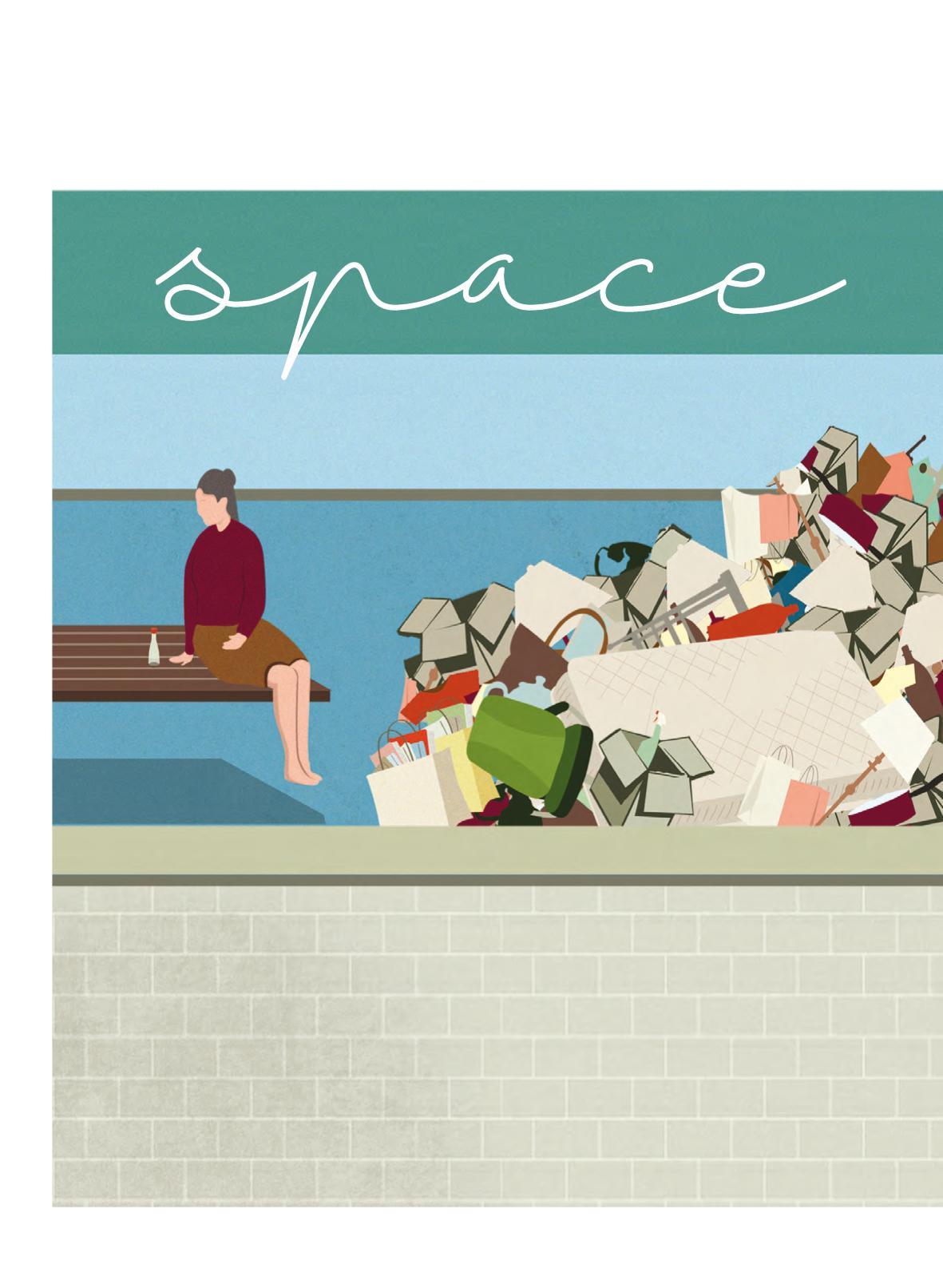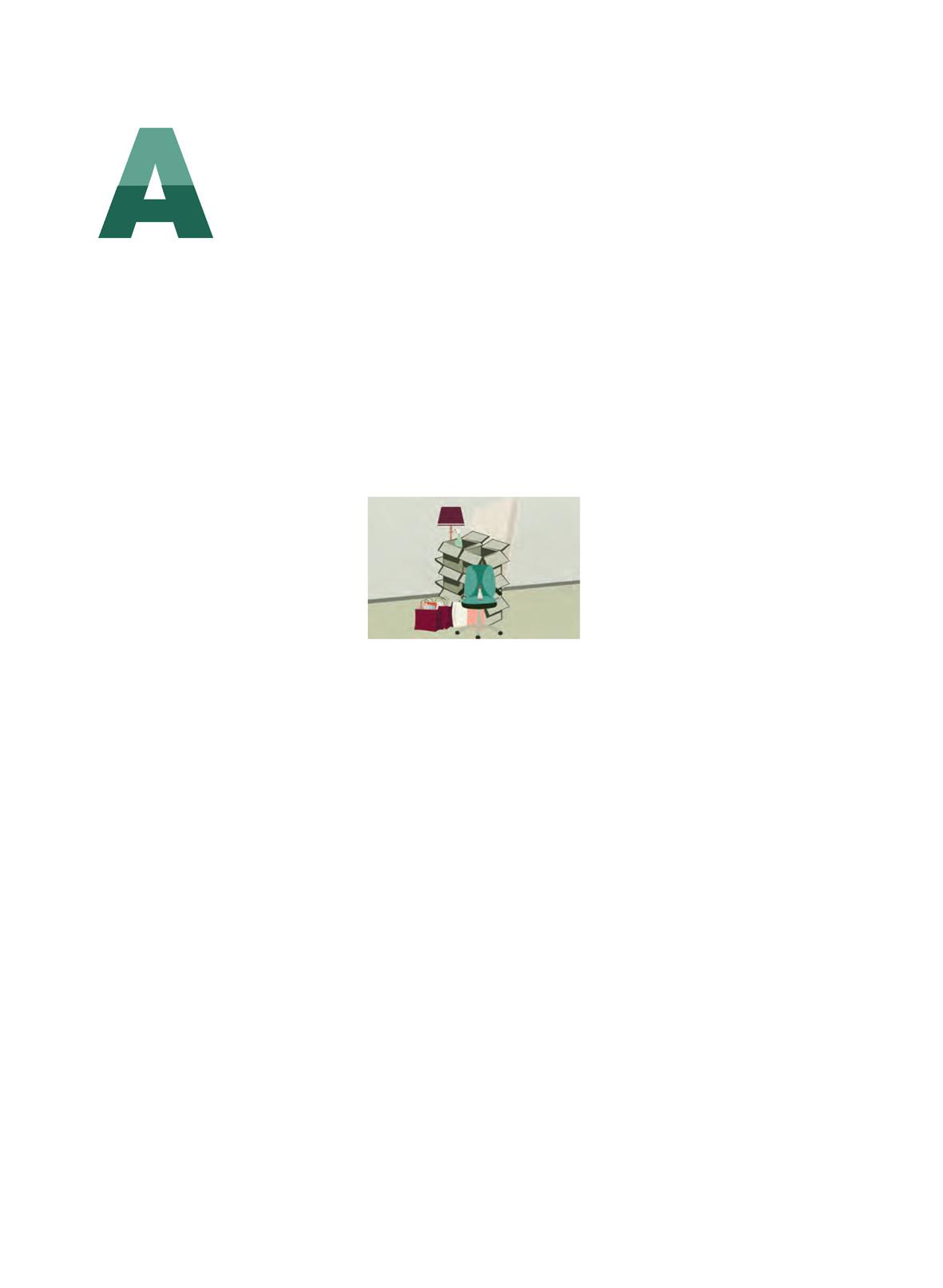
9 minute read
THE SPACE BETWEEN
THE

Advertisement
BETWEEN
Empty shopping bags, broken chairs, stacks and stacks of magazines—when writer Christina Gonzales realized her mom might be a hoarder, she went to the experts to find out how she could help, and repaired their relationship in the process.
T MY MOTHER’S APARTMENT, there confrontation about the kitchen cupboards. But this are a lot of unspoken rules. “Don’t open time, I realized I didn’t want the cycle to continue; the the kitchen cabinets” is one of them. I’ve bitterness I’d carried with me for years had to cease in only ever used one cupboard, which is right above the order for us to have a healthy relationship. sink and houses the sieve, a few large ceramic bowls and What I’d always found most challenging was that she the few packs of ramen noodles that haven’t yet gone couldn’t see where I was coming from—she truly doesn’t bad. I try not to ask my mom what’s in the rest of those realize her belongings are piling up around her. Yet, she’s cupboards, or why our pots and pans are piled beside unlike the people I’ve seen on the TLC show Hoarding: the stove and our dishes never leave the drying rack. Buried Alive; she’s physically healthy, she’s about to retire I brought up the subject once in aggravation when from a successful career and she has an active social life. I moved back home two years ago to save money. “You’re She’s also been a giving, supportive and loving mother. So too much, Christina,” she responded angrily. It instantly what’s the deal? I approached several specialists to help brought me back to my childhood. give me insight into my mother’s hoarding issue.
As a kid, I was close with my mother, despite her Dr. Peggy Richter, a psychiatrist and the director of inability to let anything go. From the outside, our family the Frederick W. Thompson Anxiety Disorders Centre’s looked normal, but when you opened the front door of Clinic for OCD and Related Disorders at Sunnybrook our two-bedroom apartment, Health Sciences Centre in it was obvious something was Toronto, says that, while their different. There were rooms houses might not look like the filled to the ceiling with souve- ones on TV, an estimated two to nirs of our past: my first mat- five percent of Canadians suffer tress from a twin-size bed I had from compulsive hoarding disoutgrown years before, reus- order. Dr. Richter explains that able shopping bags, pillows, hoarding is more than the suitcases, books, a lime-green inability to throw things out. swivel chair. My mom’s dresser overflowed with so many There were rooms filled “Rather, to be considered a clinical condition, it results in accessories, half-used bottles to the ceiling with a significant accumulation that of body lotion, old blush com- souvenirs of our past: impacts the ability to use the pacts and loose coins that you my first mattress from space the way you would like or couldn’t even see the wooden a twin-size bed I had the way most people would,” surface. A layer of dust covered everything, which meant she didn’t use—or even touch—the stuff. I was humiliated that our outgrown years before, reusable shopping bags, pillows, suitcases, she says. “And people may try to minimize the impact. For example, maybe their kitchen is quite cluttered; they can still home was so disorderly. books, a lime-green make breakfast, but they have
The clutter really began to swivel chair. piles in front of the oven, so accumulate when I was about they never use it anymore, 11 years old. My mom stopped inviting people to our though they claim they never did. Similarly, someone home, and I stopped, too. My best friends in high school whose bed is too cluttered may claim that she prefers, and asked me why we’d never hang out at my place, and I did is more comfortable, sleeping on the couch.” my best to dodge their questions. My frustration Elaine Birchall, a social worker and hoarding behavstemmed from jealousy (why couldn’t my mom entertain iour and intervention specialist with clients in Ottawa the way other moms did?) and a fundamental difference and Toronto, says hoarders tend to save things for one of in what we thought “home” should mean (I longed to live three main reasons: sentimental (this item represents my in a house filled with family and friends; she thought life and is part of me), intrinsic (this item is amazing and home should be a private retreat). I would cry, yell and offers so many possibilities) or instrumental (I might plead with her to throw things away, until my teen years, need this someday). I think my mom is a sentimental when I started to distance myself emotionally from her. hoarder. She once mentioned that her own mother disI knew that no matter what I said or did, I couldn’t carded her childhood trophies and awards and that she control my mother’s hoarding, and it was easier to avoid wished she still had those things to help her reminisce. her—and the subject of home—altogether. There’s a certain glee she gets from pulling out an item
When I moved back home at 28—I’d quit my day job that someone else would’ve thrown away long ago, like to pursue a full-time freelance writing career, and my the cheerleading catalogue my now-40-year-old cousin mom offered up my childhood bedroom as a way to was featured in when she was in high school in the ’90s. save money—it didn’t take long before we had our “It’s so nice. Maria was so pretty,” she’d say.

Dr. Sheila Woody, a professor of psychology and psychology researcher at the University of British Columbia’s Centre for Collaborative Research on Hoarding in Vancouver, shed some light on how to approach my mom’s hoarding disorder respectfully and without judgment. “Making your mom’s apartment a place you want to live is not an appropriate goal,” says Dr. Woody, noting that people with hoarding disorders don’t realize the impact of their mountains of possessions. I first needed to accept that this apartment would never become what I’d always perceived as the ideal home. There was one thing that I could change, though, and that was the usability of the space. “If you’re trying to make it so that [your mom isn’t] at risk of falling over when she’s trying to reach something, or not at risk of setting the house on fire when she turns the stove on, that’s a very reasonable goal,” says Dr. Woody, who adds that it’s also important for there to be adequate room to get out of the apartment in case of an emergency.
To ensure that my mom’s apartment was no longer a hazardous zone, I began to help her discard what Birchall calls the “easy wins”: For some, these are nostalgia-free items (such as old toothbrushes and grimy shoes) and those that are unsanitary (like expired food); for others, they’re items the person feels no extreme need to save. Birchall recommended I calmly ask my mom if we could relocate old things to make room for new items we’d actually use. I did it for the first time a few months ago, when I called her from the grocery store to ask if we had soy sauce. When my mom went and retrieved it, she told me that it was expired. “OK, I’ll buy a new bottle, and you can ditch the old one,” I responded. When I arrived home, it was sitting on the kitchen counter ready for disposal.
In my childhood, I would’ve taken the bottle down to the garbage chute that instant, a nonverbal signal that there was absolutely no reason to keep expired condiments. Now, I understand that getting rid of things causes her real distress. Instead of feeling exasperated and ashamed, all I felt this time was guilt. I realized that I’d been acting like a punishing drill sergeant, pushing my agenda onto my mother by barking at her to see things my way. And, according to Birchall, that’s exactly the wrong approach. “Even when my patients want to hold on to genuine garbage, unless it’s contaminated, I have to do my level best to make them see the reality of this,” she says. “And even then, I don’t just try to get someone to agree to let go of something; I try to understand what the importance of that item is to them.”
So I didn’t ask my mom when she planned on discarding the soy sauce; I knew it wasn’t a sentimental item and that she was practical enough to understand it wasn’t safe to consume. There was no fight, no power struggle, no “I’m right, and you’re wrong.” Rather, I gave her the space to decide when it was the right time—if there was a right time—to throw out the bottle. I tried my best to be patient, to have a stress-free conversation and to respect the value of my mom’s belongings while holding firm to my boundaries within our shared space. It’s a slow process, but it’s effective. Showing compassion for my mom’s feelings about her stuff makes it easier for her to let things go. When I push too much, we backtrack on any progress we’ve made.
The day after our conversation, I walked into the kitchen and that old bottle of soy sauce was gone. It was a small step, but for me—and my mom—it was a breakthrough.

STEPS forward
Social worker and hoarding specialist Elaine Birchall gives her best advice for helping a hoarder.
1 Complete a safety
audit. Find the heat sources, such as electrical panels, fireplaces, hot water tanks, furnaces and stoves, and make sure there is a clearance of at least four feet around them, if space allows. The paths to those heat sources must also be free and clear in case of fire and should be at least 33 inches wide.
2 Create boundaries and limits, especially if you live in the same home as the hoarder.
Build a positive cotenant dynamic by defining who “owns” each room and what is allowed in each space. Common areas must be clear so that all tenants can use the space and have a social life.
3 Decide on permanent spaces.
A permanent place is a storage area that makes sense for an item. For example, you’d never store canned goods under the bed—you’d put them in a kitchen cupboard or pantry. When choosing a permanent place, hold the item and close your eyes. Ask yourself, “Where is the first place I’d look for this?” That is where it should be.
4 Do your research.
Rather than insisting that you know why the hoarder should part with an item, find an appropriate expert source. For example, if a hoarder wants to keep expired foods, go to the Canadian Food Inspection Agency; the organization’s website will explain why it’s unsafe to keep around.
5 Show respect.
Don’t apply pressure. Work at the hoarder’s pace and don’t diminish his or her feelings. Try to put yourself in that person’s shoes by doing a mental tally of 20 possessions you love and imagining how you might feel if a family member made you throw them away.










